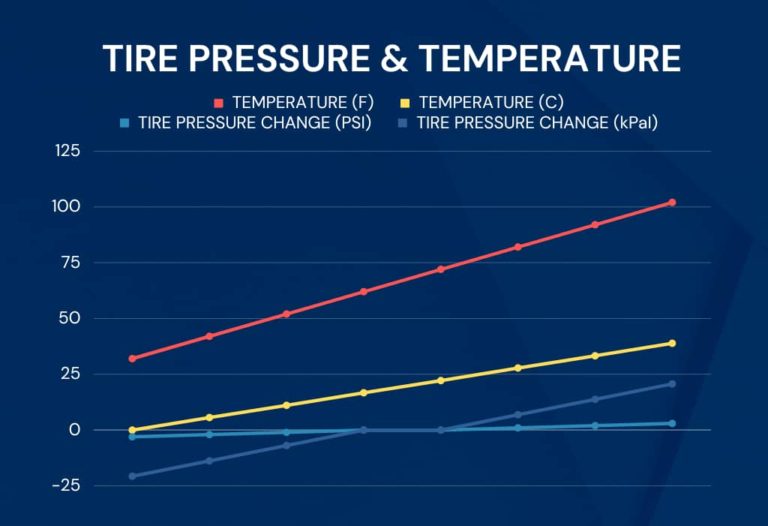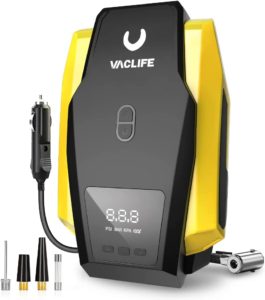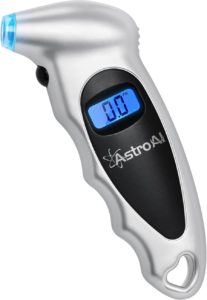Steps to Reset Hyundai Santa Fe Tire Pressure Light
Step 1: Check and Adjust Your Santa Fe Tire Pressure
The Hyundai Santa Fe doesn’t have a specific button for resetting the tire pressure. To switch off the tire light, make sure all four tires are inflated to the right pressure. You can find the proper pressure by checking the sticker inside the driver’s side door frame, looking at the chart below, or using the Mode button on your steering wheel to access the tire pressure display. Make sure you set your tires to EXACTLY 35 Psi. Remember to adjust your tire pressure only when the tires are cold to get accurate pressure levels. This is typically before going on long drives or after your car has been parked for several hours.
Step 2: Drive your Santa Fe
After inflating your tires to the recommended cold pressure, take your Santa Fe out for a drive. Drive for a few minutes at speeds above 20 mph. You may encounter a message stating “drive to display.” As you keep driving, the tire pressure light will eventually turn off. If it doesn’t go off right away, continue driving for a little longer.
Step 3: Re-check the Tire Pressure
If the tire pressure light still stays on after completing steps 1 and 2, make sure to recheck your tire pressure to confirm it’s at the exact level you set it to. If it’s not, there is probably a leak in the tire or valve stem. If the tire light goes off after inflating the tires but comes back on after driving, it’s likely you have a tire leak. Should the tire pressure light blink or flash before remaining on, this suggests that your tire pressure system is experiencing a malfunction. (keep reading to learn about this)
2023 Hyundai Tucson Tire Pressure
Match your tire size to the chart below:
Tire Size | FRONT PSI | REAR PSI |
235/60R18 | 35 | 35 |
235/55R19 | 35 | 35 |
255/45R20 | 35 | 35 |
SPARE TIRE | 60 | 60 |
Hyundai Santa Fe TPMS Malfunction Indicator
The Hyundai Santa Fe’s tire pressure monitoring system (TPMS) features a built-in malfunction indicator. This indicator uses the same yellow exclamation point tire warning light as the low-pressure warning. If there’s an issue with the TPMS, the warning light (yellow exclamation point) will flash for about a minute before staying on. This flashing sequence will recur each time you start your car until the problem is resolved.
It’s essential to realize that while the indicator is active, the TPMS may not function correctly, meaning your tire pressure monitoring system won’t operate as intended until the TPMS issue is fixed. In other words, a blinking tire pressure light indicates a problem with the TPMS itself, usually a defective pressure sensor in one of your tires, rather than an actual air pressure issue.
To determine which tire sensor is causing the problem, you’ll need a TPMS diagnostic tool, like the Autel TPMS tool. (I’ve been using Autel TPMS diagnostic tools for several years and highly recommend them.)
When Should You Reset Your TPMS?
After inflating tires to the recommended cold pressure
When you’ve replaced one or more tires
After rotating your tires
If you’ve repaired a punctured tire or fixed a leak in the valve stem
When seasonal temperature changes significantly impact tire pressure. (learn more about this below)
If the TPMS warning light flashes or stays on, indicating a malfunctioning system
After replacing a faulty tire pressure sensor in one of your tires
How Hyundai Santa Fe TPMS Works
Continuous monitoring: The Hyundai Santa Fe TPMS uses pressure sensors mounted inside each tire on the valve stem. These sensors continuously monitor the air pressure in each tire and send data wirelessly to the car’s onboard computer.
Dashboard warning light: If any tire’s pressure falls below approximately 15%-25% of the recommended level, the TPMS will trigger a yellow exclamation point warning light on the dashboard. This serves as an alert to the driver that they need to check and adjust the tire pressure ASAP.
Built-in malfunction indicator: The tire pressure monitoring system is designed with a built-in malfunction indicator that uses the same yellow exclamation point warning light to signal a system malfunction. In case of an issue, the light will flash for about a minute before remaining on, indicating a problem with the TPMS itself, such as a faulty sensor or communication error between the sensors and the car’s computer.
Adaptive response to pressure changes: The TPMS can detect significant changes in tire pressure caused by factors like temperature fluctuations, punctures, or slow leaks. By quickly alerting the driver to these changes, the system helps maintain proper tire pressure.
Compatibility with diagnostic tools: To diagnose and troubleshoot TPMS issues, specialized tools like the Autel TPMS tool can be used. These tools will help you pinpoint which sensor is problematic, making it easier to address the issue and fix the problem.
What Causes the Santa Fe Tire Pressure Light to Turn On?
The Hyundai Santa Fe tire pressure light can come on for various reasons, signaling potential issues that need your attention. Here’s a list of causes:
Low Tire Pressure: The most frequent cause for the TPMS light to activate is when the pressure in one or more tires falls below the recommended level. This can happen due to a slow leak, puncture, or natural pressure loss over time.
TPMS Malfunction: This usually happens due to a defective sensor, a dead or weak sensor battery, or communication difficulties between the sensor and the car’s computer.
Seasonal Changes: Temperature variations can impact tire pressure. This is very common in colder weather. The TPMS light will illuminate when substantial pressure changes arise from seasonal temperature changes. (read more on this below)
Tire Rotation or Replacement: The TPMS light may turn on after a tire rotation or replacement if the system needs resetting due to tire location change or if the tires haven’t been inflated to the correct pressure after the service.
New Wheel or Tire Size Installation: If you’ve installed new wheels/rims or changed tire sizes, the TPMS light could activate if the system hasn’t been recalibrated for the modifications. This will also be an issue if you replace a wheel/rim and don’t transfer the sensors from the old wheel to the new one.
Disconnected or Replaced Vehicle Battery: The TPMS light might be triggered if the car’s battery has been disconnected, replaced, or jumped, as this could necessitate a system reset.
Sensor Damage: Physical damage to a TPMS sensor, such as from impact, corrosion, or improper installation, can cause the TPMS light to turn on. I’ve seen many times where the rubber gasket between the valve and sensor goes bad, leading to a leak. The rubber gasket can be replaced without having to replace the entire sensor.
How Does the Weather Affect My Tire Pressure?
The graph above shows us how air temperature affects tire pressure. It shows that when it gets colder outside, tire pressure decreases, and when it gets warmer, tire pressure increases. A good reference point to keep in mind is around 62°F (16.7°C), as that’s the temperature where tire pressure generally stays stable. Basically, for every 10-degree drop in air temperature, your tire pressure will go down by about 1 PSI.v
Benefits of TPMS in Hyundai Santa Fe
Enhanced safety: The TPMS helps maintain proper tire pressure, which reduces the risk of tire blowouts, improves traction, and ensures better handling while driving your Hyundai Santa Fe.
Improved fuel efficiency: By monitoring and maintaining optimal tire pressure, the TPMS can help you achieve better fuel economy, saving you money on gas.
Prolonged tire life: Proper tire pressure helps reduce uneven wear on your tires, extending their lifespan and saving you money on replacements.
Environmental benefits: Better fuel efficiency and reduced tire wear contribute to a lower carbon footprint, making you and your Hyundai Santa Fe more environmentally friendly.
Early warning system: The TPMS alerts you to low tire pressure or potential issues with the system itself, enabling you to address problems before they become more serious or costly.
Increased driving comfort: Optimal tire pressure promotes a smoother ride, providing you and your passengers with a more comfortable driving experience.
Peace of mind: Knowing that your Hyundai Santa Fe’s TPMS is continuously monitoring tire pressure helps you feel more confident and secure while driving.
Conclusion
Understanding and resetting the tire pressure warning light on your 2023 Hyundai Santa Fe is important. By following the steps detailed in this article, you can guarantee that your tire pressure monitoring system operates properly, and your Hyundai Santa Fe performs at its best. Be sure to check your tire pressures at least once every few weeks and before taking any trips!
Everything mentioned in this article applies to all Hyundai Santa Fe models and trims. This includes Hyundai Santa Fe Hybrid and Santa Fe Plug-in Hybrid.
Please note that this blog post contains Amazon affiliate links. This means that if you make a purchase through one of these links, we at TPMSRESET.com may earn a small commission at no extra cost to you. We only recommend products that we personally use and believe in. Thank you for supporting this us.





